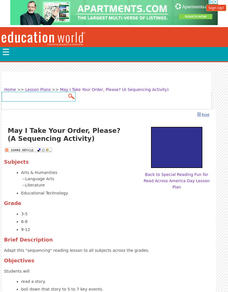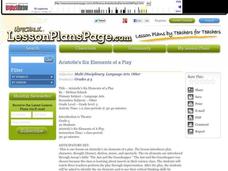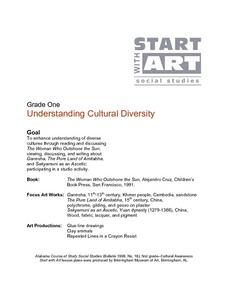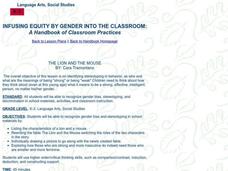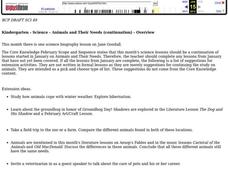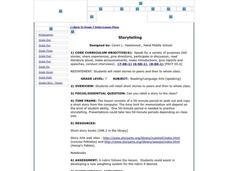Curated OER
All About Aesop
First graders explore the genre of fables. In this fables lesson, 1st graders use various reading strategies to raise comprehension skills. Students make prediction and complete a prediction journal. Students understand that fables have...
Curated OER
Acting Like a Bunch of Animals: Fables and Human
The video "The Tales of Aesop" traces for viewers the history of fables and identifies their characteristics. The class then goes to the web site "The Fisherman and the Little Fish" where they examine the classic and a modern version of...
Curated OER
May I Take Your Order, Please?
Pupils read a story, boil down that story to 5 to 7 key events, create a sequencing quiz to go with the story and have their classmates take the quiz. They will the strategy of sequencing by reading various stories (that they are not...
Curated OER
A Sip of Aesop From the Web
Third graders answer specific questions by conducting an Internet scavenger hunt. They write their own fable after reading many different fables on the Internet. They questions that they answer are included in this instructional activity.
Curated OER
Kindness Fables
Middle schoolers create a fable that is based on kindness. In this fables lesson plan, students read and discuss different fables. Then they discuss kindness, and write their own fables based on the kindness of others.
Curated OER
Who's Got Game? The Lion or the Mouse?
Discuss bullying, folk tales, and more using this resource. Learners read the story The Lion and the Mouse by Toni and Slade Morrison, engage in cause and effect activities, make predictions, and discuss bullying. This is a motivating...
Curated OER
Tortoise and Hare Races
Practice basic map skills with the story of The Tortoise and the Hare. After listening to the story, class members create a map that indicates the starting line, the path the animals took, where they stopped to rest, and the finish line....
Curated OER
Writing Fables
Students develop a working skill of using graphic organizers for writing. The instructional activity notes that the best kind of organizer is one that is engaging to the appropriate audience. The assessment follows the rubric given in...
Curated OER
Tortoise and Hare Races
Students listen to the fable, The Tortoise and the Hare, and participate in various map skill activities. They manipulate magnetic tortoises and hares on metal cookie sheets to practice direction, and construct racing tortoises out of...
Curated OER
Latino Folklore and Culture: Stories of Family, Traditions of Pride
Students define the terms fable and folktale. They write a fable to illustrate a Latino proverb. Students are explained that a folktale is a story passed down through the oral tradition of a particular culture. A fable is a type of...
Curated OER
The Lion and the Mouse
Students write a story. In this critical thinking and writing lesson, students read a fable, answer the provided thinking skills questions, and write their own fable.
Curated OER
Folktales: Fables
Pupils access a variety of resources on the Internet regarding folktales, fables, tall tales, and fairy tales. They read and compare/contrast the elements of fables, and complete various handouts.
Curated OER
Teaching Language Arts in Kindergarten Using Stories, Aesop's Fables, and Tall Tales
Students search into a variety of story elements in the eight lessons of this unit. The title, author, illustrator, setting, main character, problem, solution, events and the story are the components of the lessons.
Curated OER
Storytelling
Students explore the origins of folktales, fairytales, myths, legends, fables, and folktales in the ten lessons of this unit. A storytelling festival is held to feature the results of the variety of activities presented in the unit.
Curated OER
A Peaceful Classroom
Students complete activities to analyze and create a peaceful environment. In this peaceful living lesson, students read about Sadako and how she is associated with peace. Students practice making paper cranes, discuss their beliefs...
Curated OER
Aristotle's Six Elements Of A Play
Fifth graders view the play, The Ant and the Grasshopper. They define Aristotle's six elements of a play. At the end of the activity, 5th graders be asked to participate in the play by acting like busy ants. This activity would tie in...
Curated OER
Understanding Cultural Diversity
First graders examine different types of art to help them explain the idea of cultural diversity. This is a unit focusing on works of art.
Curated OER
Lesson Plan: Final Phoneme ll, ff, ss
Students apply word level skills through shared and guided reading.
Curated OER
THE LION AND THE MOUSE
Students listen to a story about different types of animals and explore how they all need each other, just like people do.
Curated OER
Jane Goodall
Students identify Jane Goodall as a scientist who studies the behavior of chimpanzees. They listen to a biography of Jane Goodall and review the location of Africa. Then students participate in an animal observation activity.
Curated OER
Storytelling
Eighth graders retell stories to peers and the entire class. In this storytelling lesson, 8th graders research short stories and select a short story to retell. Students rewrite the stories in their own words and tell it aloud.
Curated OER
Kindness Counts Book
Students listen to stories about kindness and discuss kindness in their lives. Students then complete Kindness Counts page, illustrating and telling story, and turn in completed page to teacher to be laminated and assembled.
Curated OER
Is It Hot in the Light?
Third graders make observations about the temperature of items in direct sunlight. In groups, they discuss why asphalt, brick and cement are warmer than items surrounding them. To end the lesson, they examine how heat transfers energy...
John F. Kennedy Center
The Kennedy Center: Masks and Aesop's Fables
This multi-media visual and language arts lesson offers intellectual, creative, and interpretive opportunities through use of books, music, and the internet. It offers complete grade-leveled lesson plans for grades k-4 which include...


